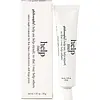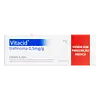What's inside
What's inside
 Key Ingredients
Key Ingredients

 Benefits
Benefits

 Concerns
Concerns

 Ingredients Side-by-side
Ingredients Side-by-side

Water
Skin ConditioningCaprylic/Capric Triglyceride
MaskingGlycerin
HumectantCetearyl Alcohol
EmollientC10-30 Cholesterol/Lanosterol Esters
EmulsifyingCetyl Alcohol
EmollientDimethicone
EmollientCetyl Ricinoleate
EmollientPolysorbate 60
EmulsifyingBenzyl Alcohol
PerfumingRetinol
Skin ConditioningTocopheryl Acetate
AntioxidantAscorbyl Palmitate
AntioxidantMethyl Methacrylate/Glycol Dimethacrylate Crosspolymer
Stearic Acid
CleansingPEG-10 Soy Sterol
EmulsifyingPhenoxyethanol
PreservativeCyclopentasiloxane
EmollientMagnesium Aluminum Silicate
AbsorbentCyclohexasiloxane
EmollientMethylparaben
PreservativeTriethanolamine
BufferingDisodium EDTA
Bisabolol
MaskingBHT
AntioxidantPolysorbate 20
EmulsifyingPropyl Gallate
AntioxidantAscorbic Acid
AntioxidantWater, Caprylic/Capric Triglyceride, Glycerin, Cetearyl Alcohol, C10-30 Cholesterol/Lanosterol Esters, Cetyl Alcohol, Dimethicone, Cetyl Ricinoleate, Polysorbate 60, Benzyl Alcohol, Retinol, Tocopheryl Acetate, Ascorbyl Palmitate, Methyl Methacrylate/Glycol Dimethacrylate Crosspolymer, Stearic Acid, PEG-10 Soy Sterol, Phenoxyethanol, Cyclopentasiloxane, Magnesium Aluminum Silicate, Cyclohexasiloxane, Methylparaben, Triethanolamine, Disodium EDTA, Bisabolol, BHT, Polysorbate 20, Propyl Gallate, Ascorbic Acid
Niacinamide
SmoothingTocopheryl Acetate
AntioxidantAscorbic Acid
AntioxidantPPG-7/Succinic Acid Copolymer
Ammonium Acryloyldimethyltaurate/Vinyl Formamide Copolymer
Emulsion StabilisingImidazolidinyl Urea
PreservativePropylene Glycol
HumectantDisodium EDTA
Cetearyl Alcohol
EmollientPolysorbate 60
EmulsifyingPetrolatum
EmollientPPG-14 Butyl Ether
Skin ConditioningBHT
AntioxidantDecyl Oleate
EmollientOleth-10 Phosphate
Dicetyl Phosphate
EmulsifyingMethylparaben
PreservativeEthylparaben
PreservativePropylparaben
PreservativeButylparaben
MaskingPhenoxyethanol
PreservativeDimethiconol
EmollientCyclopentasiloxane
EmollientCyclomethicone
EmollientParfum
MaskingWater
Skin ConditioningNiacinamide, Tocopheryl Acetate, Ascorbic Acid, PPG-7/Succinic Acid Copolymer, Ammonium Acryloyldimethyltaurate/Vinyl Formamide Copolymer, Imidazolidinyl Urea, Propylene Glycol, Disodium EDTA, Cetearyl Alcohol, Polysorbate 60, Petrolatum, PPG-14 Butyl Ether, BHT, Decyl Oleate, Oleth-10 Phosphate, Dicetyl Phosphate, Methylparaben, Ethylparaben, Propylparaben, Butylparaben, Phenoxyethanol, Dimethiconol, Cyclopentasiloxane, Cyclomethicone, Parfum, Water
Ingredients Explained
These ingredients are found in both products.
Ingredients higher up in an ingredient list are typically present in a larger amount.
Ascorbic Acid is is pure Vitamin C. This form makes up the largest amount of vitamin C found naturally in our skin.
Not only is vitamin C great for your overall health and immune system, it also has plenty of benefits on your skin.
Vitamin C is best used for brightening skin. It improves dark spots, acne scars, and hyperpigmentation. This is because it blocks the process of skin darkening when exposed to UV.
Remember: Vitamin C should not replace sunscreen!
Your skin uses vitamin C to build collagen. Collagen is one key component in having a strong skin barrier and plump skin. Vitamin C also plays a role in regulating collagen, thus making it effective in improving wrinkles and fine lines.
Ascorbic acid shows potent antioxidant activity. As an antioxidant, it helps fight free-radicals. Free-radicals are molecules that may damage your skin cells. These antioxidants also protect skin against UV damage.
The best formulations include Vitamin E and/or ferulic acid. These two ingredients help stabilize and provide a boost in the benefits of ascorbic acid. This is because ascorbic acid becomes unstable when exposed to UV and air. In fact, you can tell your ascorbic acid has oxidized when it turns an orange-yellow color.
Ascorbic acid is generally compatible with other ingredients. However, using ascorbic acid with other active ingredients might cause irritation. Two ingredients: copper ions and benzoyl peroxide, will inactivate ascorbic acid completely.
Read more about other types of Vitamin C:
Foods rich with vitamin C include oranges, strawberries, broccoli, bell peppers, and more. When consuming Vitamin C, your skin receives a portion of the nutrients.
Learn more about Ascorbic AcidBHT is a synthetic antioxidant and preservative.
As an antioxidant, it helps your body fight off free-radicals. Free-radicals are molecules that may damage your skin cells.
As a preservative, it is used to stabilize products and prevent them from degrading. Specifically, BHT prevents degradation from oxidation.
The concerns related to BHT come from oral studies; this ingredient is currently allowed for use by both the FDA and EU.
However, it was recently restricted for use in the UK as of April 2024.
Learn more about BHTCetearyl alcohol is a mixture of two fatty alcohols: cetyl alcohol and stearyl alcohol. It is mainly used as an emulsifier. Emulsifiers help prevent the separation of oils and products. Due to its composition, it can also be used to thicken a product or help create foam.
Cetearyl alcohol is an emollient. Emollients help soothe and hydrate the skin by trapping moisture.
Studies show Cetearyl alcohol is non-toxic and non-irritating. The FDA allows products labeled "alcohol-free" to have fatty alcohols.
This ingredient is usually derived from plant oils such as palm, vegetable, or coconut oils. There is debate on whether this ingredient will cause acne.
Due to the fatty acid base, this ingredient may not be Malassezia folliculitis safe.
Learn more about Cetearyl AlcoholCyclopentasiloxane, or D5, is a silicone used to improve texture of products and trap moisture.
D5 is considered lightweight and volatile. Volatile means it evaporates quickly after application. Once evaporated, D5 leaves a thin barrier that helps keep skin hydrated.
It is also an emollient. Emollients help soften the skin and prevent water loss. Silicones create a silky texture in products. D5 helps other ingredients become more spreadable.
Studies show D5 is safe to use in skincare products. We recommend speaking with a skincare professional if you have concerns.
Learn more about CyclopentasiloxaneDisodium EDTA plays a role in making products more stable by aiding other preservatives.
It is a chelating agent, meaning it neutralizes metal ions that may be found in a product.
Disodium EDTA is a salt of edetic acid and is found to be safe in cosmetic ingredients.
Learn more about Disodium EDTAMethylparaben is a preservative and is a paraben. It is used to prevent the growth of fungus, mold, and other harmful bacteria. Parabens are chemicals used as preservatives in both cosmetics and food.
Methylparaben can be synthetically created. It can also be found naturally in some fruits, such as blueberries.
Oftentimes, Methylparaben is combined with other parabens to help increase the shelf life.
The safety of Methylparaben is currently being studied. While ongoing studies are looking into the safety of parabens, the results have been very mixed. Some studies have not found Methylparaben to be harmful.
Learn more about MethylparabenPhenoxyethanol is a preservative that has germicide, antimicrobial, and aromatic properties. Studies show that phenoxyethanol can prevent microbial growth. By itself, it has a scent that is similar to that of a rose.
It's often used in formulations along with Caprylyl Glycol to preserve the shelf life of products.
Polysorbate 60 is used to help stabilize products. It is a surfactant and emulsifier. These properties help keep ingredients together in a product. Surfactants help reduce surface tension between ingredients with different states, such as liquids and solids. Emulsifiers help prevent oils and waters from separating.
Polysorbate 60 is sorbitol-based and created from the ethoxylation of sorbitan. Ethoxylation is a chemical reaction used to add ethylene oxide. Sorbitan is a the dehydrated version of sorbitol, a sugar found in fruits.
In this case, the 60 comes from reacting 60 units of ethylene oxide with sorbitan.
Polysorbates are commonly used in medicine and foods.
Learn more about Polysorbate 60Tocopheryl Acetate is AKA Vitamin E. It is an antioxidant and protects your skin from free radicals. Free radicals damage the skin by breaking down collagen.
One study found using Tocopheryl Acetate with Vitamin C decreased the number of sunburned cells.
Tocopheryl Acetate is commonly found in both skincare and dietary supplements.
Learn more about Tocopheryl AcetateWater. It's the most common cosmetic ingredient of all. You'll usually see it at the top of ingredient lists, meaning that it makes up the largest part of the product.
So why is it so popular? Water most often acts as a solvent - this means that it helps dissolve other ingredients into the formulation.
You'll also recognize water as that liquid we all need to stay alive. If you see this, drink a glass of water. Stay hydrated!
Learn more about Water